Symptoms
In Britain the first symptoms are visible on infected needles from September. Generally older needles are affected, and typically develop yellow and tan spots and bands, which rapidly turn red. Another characteristic symptom is the way the ends of infected needles then turn reddish-brown whilst the needle base remain green.
Unfortunately the red banding is not always evident, and the needles might have an overall brown or reddish colour which can easily be confused with symptoms caused by other needle diseases.
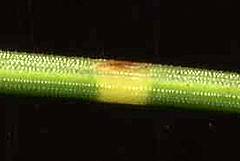
Initial symptoms on needles of yellow bands and tan spots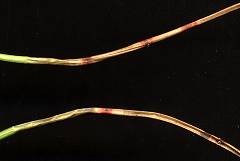
Infected needles showing tip dieback, red bands and small black fruit bodies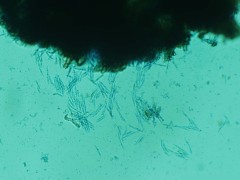
Spores of
Dothistroma septosporum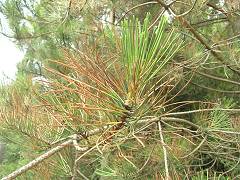
Close-up view of symptoms showing reddish-brown needle ends and green bases
Needle symptoms are most apparent in June to July. After this the infected needles are shed and twig and branch ends can have a typical ‘lion's tail’ appearance, with only a tuft of the current year's needles remaining at the branch ends.
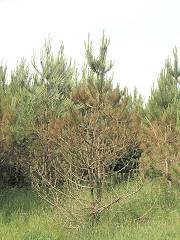
Dothistroma needle blight causing defoliation of Corsican pine from the base of the crown upwards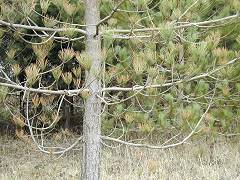
Intense infection on lower branches showing ‘lion’s tail’ appearance
This defoliation can continue year on year and gradually weaken the tree, significantly reducing timber yields and eventually leading to death.
Life cycle
The fungus reproduces by forming small, black fruit bodies on the needles, and these are usually seen within the red bands. Spores are released from these, and if they land on a susceptible host, they germinate on the needle surface and grow through the stomata.
The period from late spring to late summer is likely to be the critical period for infection, and severe episodes of the disease appear to be correlated with wet springs and higher than average rainfall. We know moisture is required for germination, and successful establishment apparently occurs at temperatures between 12oC and 18oC under conditions of high humidity. Once this period of spore release is over, the tree sheds the needles that contain the spent fruit bodies.
Where the fungus establishes successfully in needles, the cycle of early symptoms of yellow bands and tan spots on the newly infected needles is repeated, with D. septosporum over-wintering in these needles and sporulating the following year. Hence infected first-year and second-year needles remain attached to the tree and are the main source of inoculum when spores are released during the following spring and summer.
